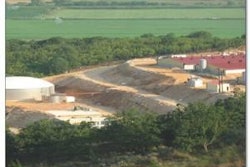Feed efficiency in the chick only reaches optimum by the 10th day post hatch.
Intestinal development is dependent on increased size of villi and microvilli, the density of enterocytes per villus area and the number of functional enterocytes along the villi. During the early post-hatch period, digestive enzymes secreted from the pancreas and small intestines are a limiting factor for nutrient digestion and utilization. It is only when the enterocyte has migrated up the villus and matured that it will secrete and activate enzyme precursors needed for digestion.
All the morphological and physiological changes in the intestine that take place during the early post-hatch period are directed toward enlargement of the absorptive surface and differentiation and maturation of the epithelial cells and initiating function of enzymes, nutrient transport systems, and activity of various immunological components.
Nutrient transporters are regulated by the ingredient composition of diets fed. Amino acid transport is influenced by dietary protein level, composition, and quality. This reality provides nutritionists with the option to feed adequate nutrients to the chick during the post-hatch period and through the successive growing and production stages. Enzyme supplements which promote digestion of specific carbohydrates and proteins are now commercially available. Digestion and absorption of lipids are reduced during the first week of age due to the relative absence of endogenous lipase and bile acids.
These two are required to emulsify and digest lipids. There are some products that help in the emulsification and digestion of dietary fats by creating much smaller micelles resulting in enhanced absorption of both fats and fat soluble vitamins. Nutrient modulation can be used as an approach to improve intestinal development, maturation, and maintenance during early growth. This results in a more healthy bird capable of efficient absorption of nutrients over the entire productive life of the hen.
Successive stages within the production cycle are associated with different nutrient demands for energy and protein. During growth, egg production, and molting, feed additives may have a positive influence by maintaining intestinal integrity and enhancing immunocompetence. This is accomplished by improving resistance to enteric viral, parasitic, and bacterial infections. Host-microbial interactions are crucial determinants of intestinal health and nutrient availability.
The small intestine and the ceca contain villi which are associated with extensive microbial activity which may influence absorption of nutrients. The intestinal microbiota influence the efficiency of digestion negatively by competing for nutrients, inhibiting digestion and absorption, deconjugating bile acids, and stimulating an immune response which diverts nutrients from growth to tissue response and antibody production. Positive interactions between microbiota and the host may include increasing absorption of nutrients from the diet and suppression of undesirable flora by competitive inhibition
Enterocytes are protected by a layer of mucin overlying the epithelium separating the localized cells of the immune system from the external environment. The epithelium also contains specialized lymphoid cells and tissues all of which make up the gastrointestinal lymphoid tissue known collectively as GALT. This is a major site for generation and induction of immune responses in the chick, since chickens do not possess lymph nodes. It takes at least 14 days for the immune system to completely differentiate and develop into a fully competent system.
The capacity of a chick to defend against disease during the first week is dependent on maternal antibody released from the yolk sac directly into the intestinal lumen of the chick. Good management during this critical time is essential. Starvation or delay in access to feed negatively affects the development and functionality of the immune status of the newly hatched chick for up to two weeks of age. During this stage as well as during production, the initiation and maintenance of a beneficial microbiota in the intestinal tract of the pullet is of great importance.
Direct-fed microbials (DFM) or probiotics allow the establishment of a desired microbiota, a reduction in pathogens and improved intestinal health. Direct-fed microbials act in diverse ways. Some DFM compete for nutrients or attachment sites on the mucosal layer of the intestine, inhibiting pathogenic bacteria. Others stimulate morphological changes in the small intestine. Some DFM will actually produce proteins to suppress the level of pathogenic bacteria in the intestinal tract.
The organisms associated with undesirable effects include Clostridium spp., Salmonella spp., and Escherichia coli. Variability among DFM may have a direct effect on the economics of raising pullets and improving subsequent production. Since some DFM do not colonize, constant feeding of these commercial products may be necessary, especially on farms with a history of infections attributable to Clostridium spp.
Producers, managers, nutritionists, and veterinarians should cooperate to build and implement effective programs for pathogen reduction and nutrition during the entire production cycle. These programs may incorporate mold inhibitors, antioxidants, and organic acids in feed and water to establish and maintain intestinal health and integrity. Flocks with good intestinal health will be able to assimilate nutrients efficiently and deposit them in higher concentrations in the egg. This is especially important for specialty and premium eggs which contain increased levels of omega-3 fatty acids, folic acid, lutein, and vitamins E and D.
Consumers are showing increased concern over food safety, healthy eating, and flock welfare. There is a significant purchasing segment willing to pay the price for what they perceive as products with enhanced attributes. A clear understanding of the physiology and development of the digestive system of pullets and hens will contribute to positive decisions relating to appropriate use of feed additives, programs to reduce pathogens and management of feeding systems.
Production of quality eggs depends on:
- Optimal management during incubation, processing, transportation, and brooding
- Pathogen reduction programs involving administration of organic acids, mold inhibitors, and antioxidants
- Use of specific enzyme and surfactants as feed additives to promote nutrient digestion and utilization

















